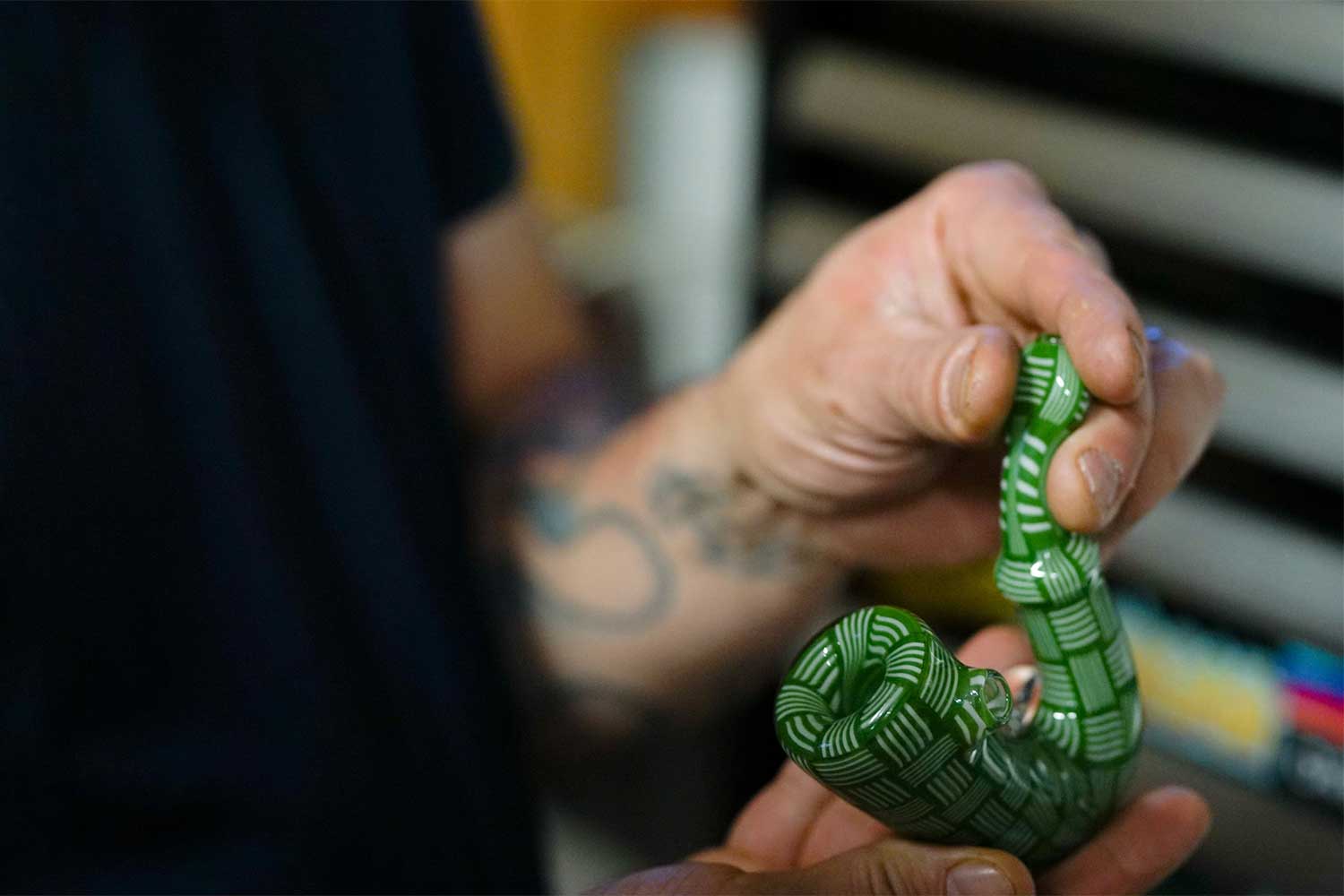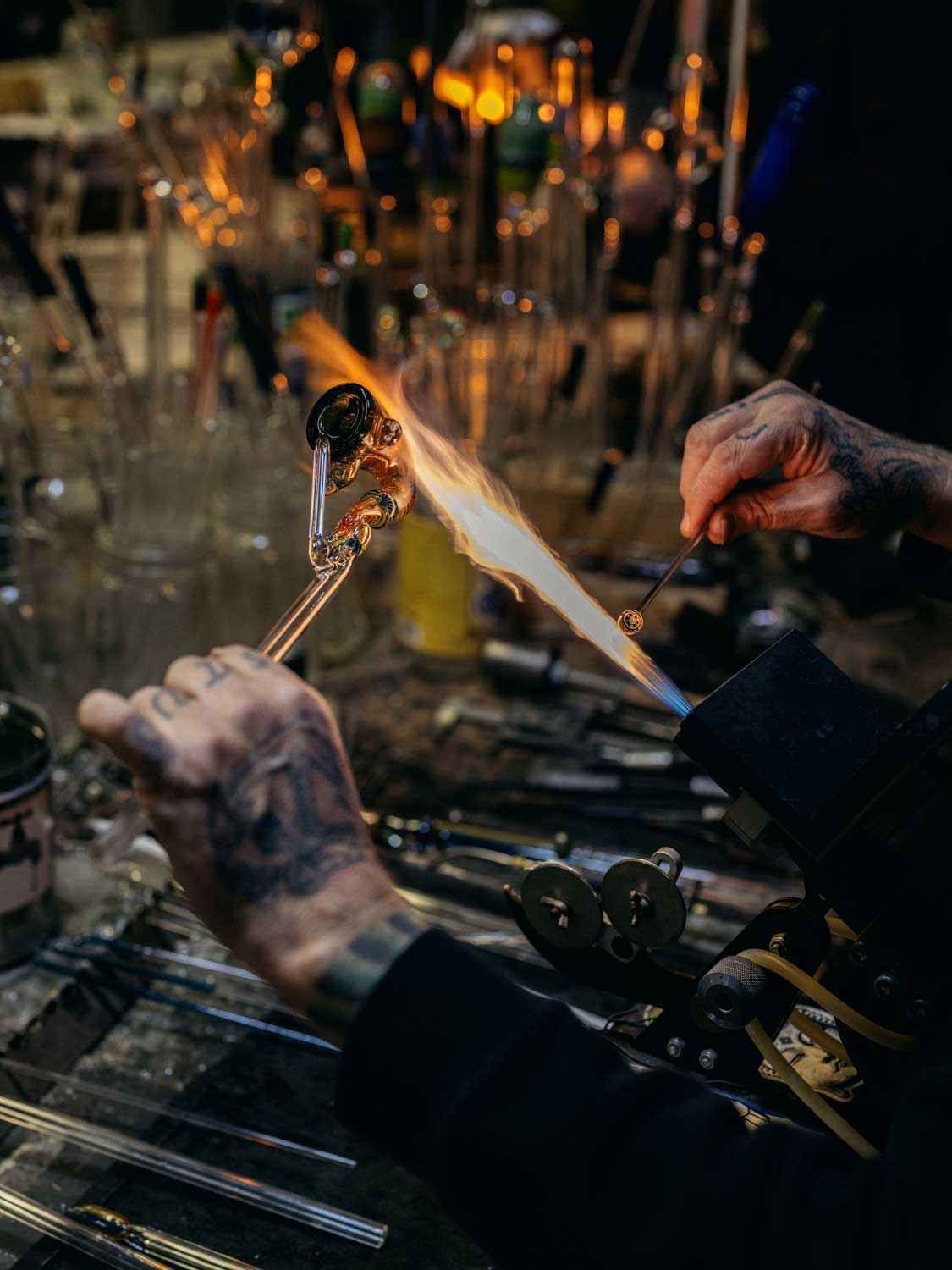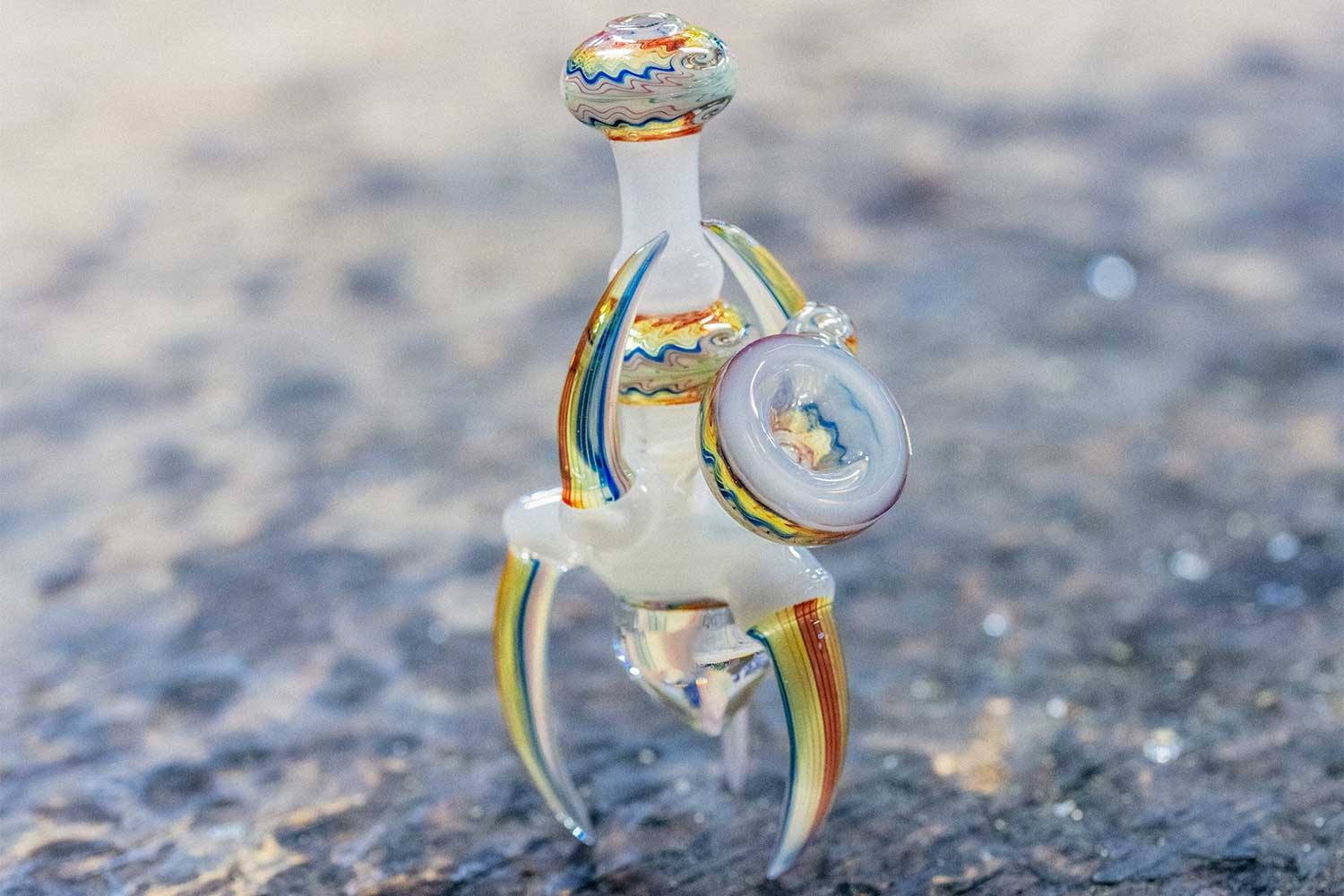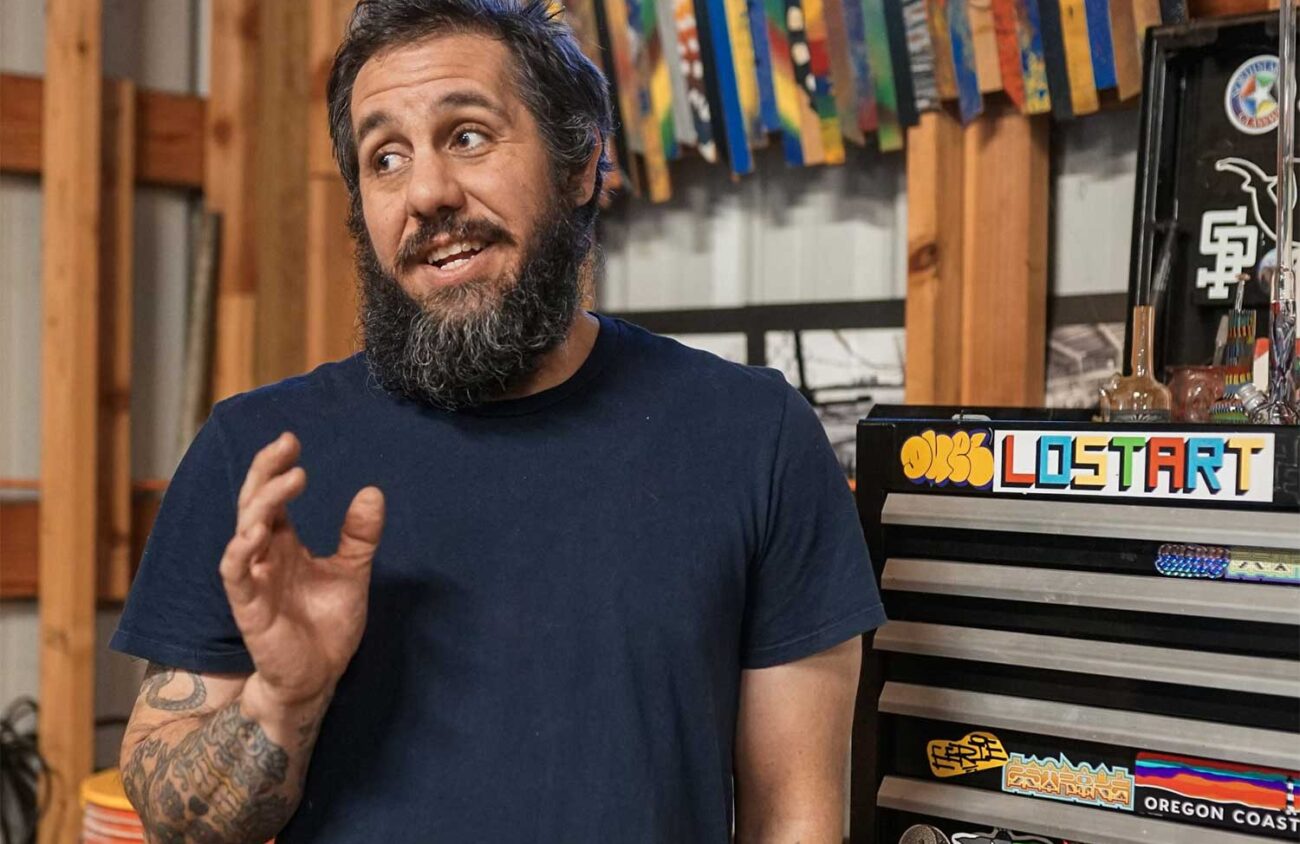In 2001 Chris Carlson was working at a checkout stand in a Los Angeles Home Depot when Tommy Chong walked through the door. Carlson didn’t smoke weed at the time. While his coworkers freaked out over the comedian of Cheech and Chong fame, 22 year-old Carlson didn’t care at all. Chong must’ve liked his apathy, because after a few interactions, he asked Carlson to help fix his glass shop’s ventilator.
“And I went and checked it out,” Carlson says of Chong Glass Works, “and it was the first time I’d ever seen glass blowing, but it was amazing.” He adds, “And all these dudes were just in there smoking cigarettes, and it was just like, this outlaw little thing that I just didn’t even realize existed.”
Carlson was hooked. He traded his orange apron for a blow torch that very same day. It was less pay than Home Depot, but he couldn’t pass it up.
Twenty-two years later Carlson is a husband, a father of four and a premier glass artist. The glass that he blows isn’t your bong from college that you remembered to clean only sometimes. He is a part of a glass community in Eugene creating highly artistic pieces selling for thousands of dollars.
Carlson started out making at least 31 pipes a day at Chong’s glass shop to “earn my bench.” He moved on to piecework, where instead of getting paid hourly he was paid per piece and had to make at least 33 glass “spoons” — smaller spoon-shaped pipes — per day.
After two years of taxing production work, Carlson and a couple other coworkers left Chong to learn a new technique in Vegas. He says it was called “inside out,” in which the artist draws a pattern on the inside of the glass and then melts it down instead of doing the pattern on the outside of the tube.
He put in his one-month notice with Chong — and was fired on the spot.
Two weeks later U.S. Attorney General John Ashcroft raided Chong’s glass shop, shut down the entire business, arrested 55 people and threw Chong in federal prison for nine months. Thirty-five indictments were issued; two of which involved Eugene Glass School founder Saeed Mohtadi and glass blower Jason Robert Harris, who together owned Jerome Baker Designs.
“Police showed up at my house at five in the morning and threw us to the ground,” Mohtadi says. “All because some employee got tricked into mailing a bong to Pennsylvania in a sting operation.”
Mohtadi and his partner Harris were put on house arrest for six months. Mohtadi says they were told by the government that they could never sell bongs again. So Mohtadi made raw materials to sell to glass blowers instead.
The case made national news and was nicknamed “Operation Pipe Dreams.”
Carlson getting fired from Chong Glass Works was a blessing in disguise; after Operation Pipe Dreams blew Chong’s glass shop up in smoke, those that made it out without a charge started an underground glass scene in Los Angeles. Carlson moved back to L.A. shortly after and started blowing glass in his mom’s garage with a friend and former co-worker from Chong Glass.
“He would blow glass in the day, and I would run the business and blow glass at night,” Carlson says.
The duo sold pipes from Venice Beach to Orange County to every glass shop that couldn’t get pipes because bigger shops were getting busted. They’d walk up and down beach boardwalks with big suitcases full of glass — mostly duplicated from Chong’s catalog.
“They wiped the big guys so we decided to seize the moment,” Carlson says.

Carlson’s work taking off coincided with the early days of the internet and social media. He stumbled upon a currently defunct website called Glasspipes.org, where people would upload their glass under aliases. Around 2003, Carlson, who was also a photographer, began posting photos of his work online under Lost Art and L.A. Glass. His work garnered attention from other glass artists who pointed him to Eugene Glass School.
In 2004, he road-tripped to Eugene with some friends from Chong’s Glass to take a class. He ended up photographing the Eugene Glass School Flame-Off and was so moved by the event he made the pilgrimage back to Eugene in 2006 to be closer to a more thriving glass community.
Carlson is known for his basket weave pattern and Sherlock pipes, which unlike traditional pipes have a curved stem and bring to mind the eponymous famous detective. He says that he feels very lucky he mastered basket weaving because few know it and even fewer know how to do it without being sloppy.
His technique involves smashing and stretching his strips of colors into a flat ribbon. From there he chops his glass into little squares to create intricate woven patterns. Carlson taught basket weaving glass classes at the world-renowned glass school, Pilchuck Glass School near Seattle.
He had a studio in the Whiteaker, right in the center of Eugene’s glass world, but during the pandemic he transformed an old barn on his property in Dexter into a studio complete with a kiln, torches and a vintage Volkswagen car collection. When Carlson isn’t blowing glass for collectors, he’s fixing old classic cars, taking pictures and making glass pendants for his daughters which he says “melts his heart” every time he sees them wear one to school.
“I prefer being closer to home, because I like being near my family,” Carlson says. “I love my job, but if I could have it my way I’d be playing with my kids all day. Working from home helps with that.”

If Eugene is a glass blowing city, the Whiteaker is the city hall. The heart of the glass blowing mecca is where friend and glass blower Chris Kerner, also known as Cowboy, has his studio, Cowboy Glass.
Kerner’s road to glass blowing began with a freak accident while riding a horse on his family’s ranch in south Texas. He thought he’d ride horses for the rest of his life until a mare flipped over on top of him causing a tumor Kerner didn’t know he had to rupture and forcing him to have emergency surgery. The surgery left him “bumming” on his mom’s couch until she essentially kicked him out to go live with his uncle in South Florida.
“It was the middle of summer and I’m dressed in starched Wrangler jeans and a button down shirt with a cowboy hat on,” Kerner says. “I was a cowboy in South Florida.”
Kerner says hippies didn’t mind his cowboy sensibilities and invited him into their world of Grateful Dead cover bands and hash.
“They nicknamed me Cowboy and everything,” he says.
Kerner and his new friends moved out to California to trim weed for a summer not long after, but he says he never really found his groove out West and missed his family. While visiting his mom at her new place in Kansas, he met a woman and ended up moving to Kansas to be with her. The couple had a baby, got married, and Kerner got a job working at a bakery. Over the summers he’d help his friends sell glass at festivals, but quietly dreamed of glassblowing until a friend of his offered him an opportunity to work under him as an apprentice.
“I quit my day job and took glassblowing like a college class,” Kerner says. “I worked 80 hours a week for three years straight.”
Glass competitions and festivals are primarily on the West Coast, which meant trips to Eugene became more and more common for Kerner. The strain of being away from his family so much led them to moving out to Eugene where glass can be a lucrative business.

Both Kerner and Carlson’s glassworks are sold across the country and can cost anywhere from $100 for a glass spoon drop to $62,000 for a bong or dab rig.
With social media on the rise and more and more head shops opting to sell imported glass; Kerner, who sells as Cowboy Glass, and Carlson who sells under the name LostArt as of 2011, primarily use Instagram as a way to market themselves to collectors.
“Instagram has been great through the years,” Kerner says. “But recently, shadow banning has become a real problem for us.” “Shadow banning” is when a platform’s algorithm restricts visibility of an account. He thinks that glass blowing’s tie to marijuana has made it more susceptible to shadow bans across Instagram.
“Instagram is a great way to connect straight to collectors,” Carlson says. “If Instagram goes down, I am in major trouble.”
Kerner and Carlson have each garnered around 50,000 followers each on Instagram for their time-consuming pieces that require a level of skill and patience backed up by years of experience.
“I’ve heard a lot of people say, ‘Wow, that looks so easy.’ That’s because I’ve been doing it for 20 years; I make it look easy,” Kerner says.
Kerner says that the process of blowing glass starts by cutting colorful sticks of glass about four inches total and sticking them inside a clear glass tube. From there, Kerner sticks the tube in a red oven, pulls it out when it starts to heat up and sticks it in his flame. Once the glass begins to move he vacuums out the air between the clear tubes, and sucks out the air pockets. He then turns the vacuum off, turns up his flame and stretches the glass. Kerner throws the glass in the kiln. “That’s just step one,” he laughs.
Once the glass is out of the kiln he stretches it to the size he wants with his flame and then goes section by section with his flame to manipulate straight lines of color into what the glass community calls “wig wags” — Kerner’s speciality.
“From the backside of it they see a piece that’s a finished piece and it’s just perfect,” Carlson says. “But there’s a dark history of it coming together. You’re ripping this section off and sawing this part off it and it exploded and went back together perfectly. Every time you’re just barely pulling it off.”
According to Kerner, Eugene has the largest glass-blowing community in the nation. For a town with more dispensaries than liquor stores, this claim isn’t all that surprising.
For years, Eugene hosted the Degenerate Flame Off, where glass blowers from across the country competed against each other to create functional glass. DFO has gotten so big that the festival is now hosted in Portland.
Out in Veneta, the Wook Festival, hosted every summer since 2020, also lends itself as a chance for glass blowers to connect and show off their pieces.
“We have a thing called ‘Holy Sundays’ where everybody from the glass community comes down here and we cook food in the parking lot,” Kerner says. “There’s music and glass blowing; it’s a real family vibe.”
While Eugene remains a hub for premiere glass artists, founder of the now-shuttered Eugene Glass School Mohtadi says he fears that COVID has created a lasting impact on community smoking and glass events, most importantly the Eugene Glass School.
“Glass blowing and smoking is a community event,” Mohtadi says. “COVID changed everything. Everything had to stop. We couldn’t host events like we used to and some of that never came back.”
For over 20 years, the Eugene Glass School taught thousands of glass blowers and hosted events like the Eugene Glass School Flame Off, where glass blowers from across the country competed against each other to create functional glass. Mohtadi says that the school used to bring in some of the best glass blowers in the world to teach color theory and foundational classes.
The Eugene Glass School shut down earlier this year due to financial troubles brought on by what Mohtadi says was a combination of imported glass dominating the market and causing glass “head” shops to stop selling local artists, the rise in edibles and vapes becoming the default way to consume THC, and finally the pandemic, which halted classes and events for months.
“We need to support more local glass artists because there is a lot of talent in this community that just isn’t getting picked up by head shops,” Mohtadi says.
Carlson and Kerner’s cult-like followings among glass collectors allow them to get by without getting picked up by glass shops. Carlson’s picture of Kerner blowing glass is the cover of the 2011 documentary Degenerate Art: The Art and Culture of Glass Pipes, which premiered at SXSW Film & TV Festival in Austin. Their work, often imitated by up and coming glass artists, has had a lasting impact in the glass scene.
“Teaching has become one of my favorite parts of my job,” says Kerner, who has had a number of apprentices over his career. “Looking back 20 years and just seeing where it’s taken some people I taught in my early years.”
While Carlson prefers not to have an apprentice, he is blown away by the new generation of glass blowers. “These new guys are just insanely good,” he says. “They’re making things I can’t even begin to understand how to do.”
Despite a new crop of glass blowers on the horizon, neither Kerner nor Carlson plan on slowing down anytime soon.
“It’s like Christmas day when you come into work and see something that took however long to make,” Kerner says. “When that day comes and you know that thing is coming out of the oven it just makes me giddy. It’s my passion in life.”Carlson’s glass can be found on his Instagram @CarlsonJones. Kerner’s pieces can also be found via Instagram @CowboyGlasss.
